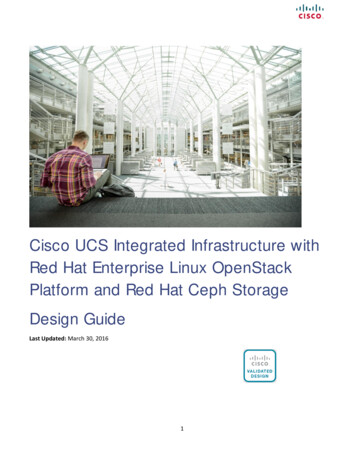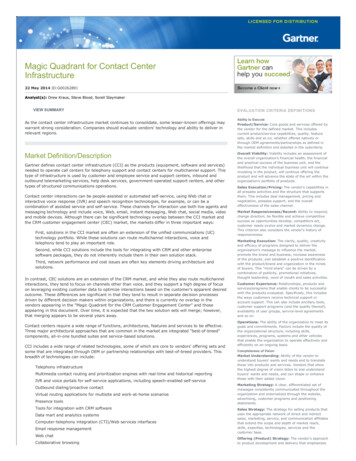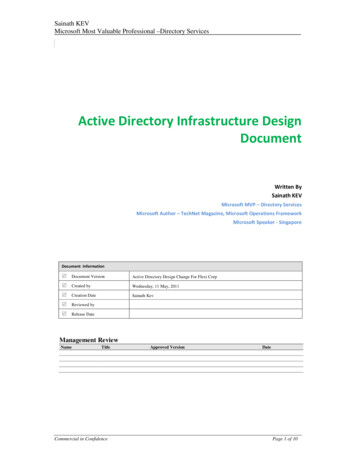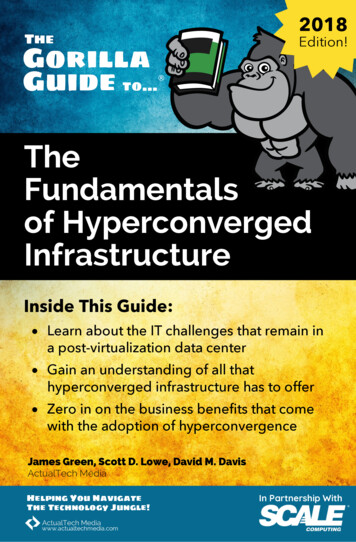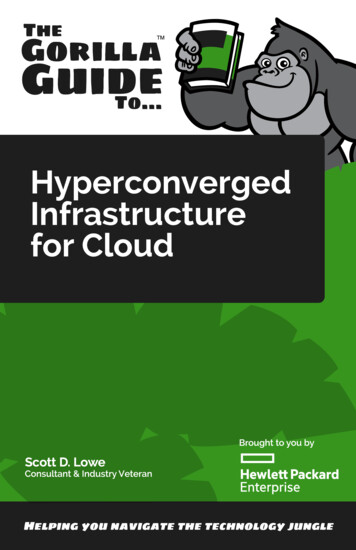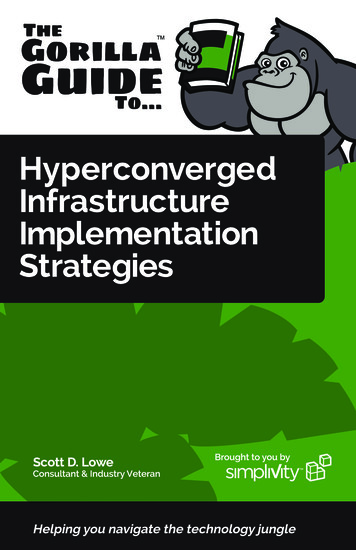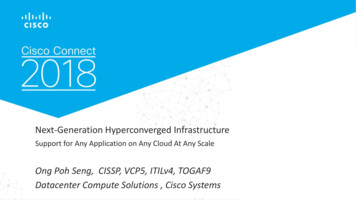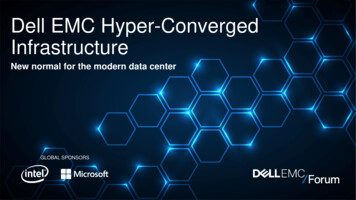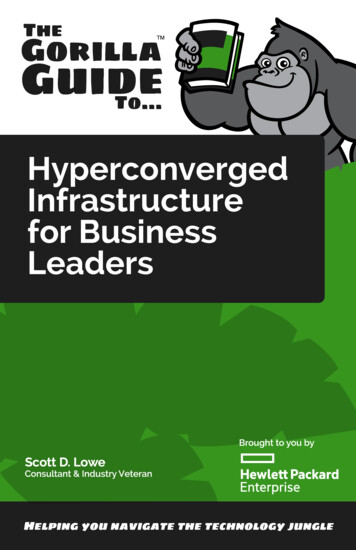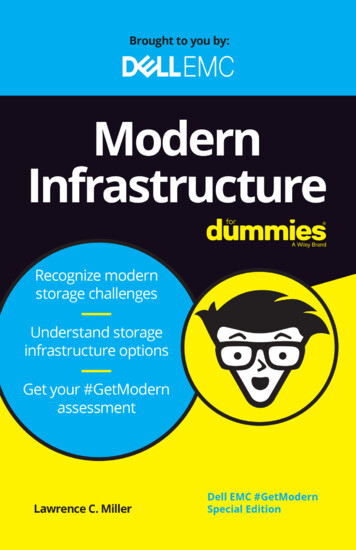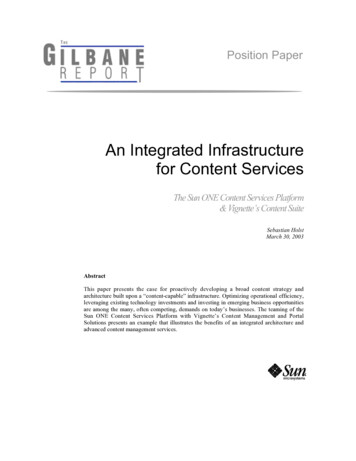
Transcription
Position PaperAn Integrated Infrastructurefor Content ServicesThe Sun ONE Content Services Platform& Vignette’s Content SuiteSebastian HolstMarch 30, 2003AbstractThis paper presents the case for proactively developing a broad content strategy andarchitecture built upon a “content-capable” infrastructure. Optimizing operational efficiency,leveraging existing technology investments and investing in emerging business opportunitiesare among the many, often competing, demands on today’s businesses. The teaming of theSun ONE Content Services Platform with Vignette’s Content Management and PortalSolutions presents an example that illustrates the benefits of an integrated architecture andadvanced content management services.
An Integrated Infrastructure for Content ServicesWhy an Infrastructure Approach?Content Volume, Diversity, and ComplexityToday’s businesses are faced with an exponential growth in business content. Manycompanies have deployed enterprise content management systems to control, leverage, andreduce the cost of managing and delivering business critical content. The problem ofmanaging enterprise content however, is too cumbersome for point-application solutions tosolve alone. Businesses need to develop a comprehensive content strategy and architecturethat is built upon a content-capable infrastructure.The increase in the volume of content is only part of the problem. Content has becomeincreasingly richer and more complex. Content is comprised of multiple data types sourced from disparate repositories anddatabases.The use of rich media content is growing, which adds new requirements inmanagement functionality, bandwidth and storage.Businesses are learning the benefits (and difficulties) of more sophisticated use ofmetadata, which compounds the complexity of content.Content in the enterprise includes a wide variety of formats, including structured databaserecords, and unstructured text, graphics, audio, video and streaming media. There are agrowing number of content application services, including web content management,document management, digital asset management, knowledge management, enterprise searchand categorization, collaboration, and syndication that focus on managing either specificcontent types, or specific aspects of the enterprise content management problem. Manymedium to large sized companies now have many of these content services in place, but whilethese provide important benefits, in most cases their real value is only realized when thecontent is integrated with larger enterprise data systems, and when a business hasimplemented disciplined, yet flexible, business process management.The good news is that more business content is being managed; the bad news is the growingcomplexity of integrating and managing all of the systems that manage the content.Content Accessibility & IntegrationMost enterprise content is tightly integrated with one or more business applications (althoughthat is not to say it is integrated with all appropriate business applications). Content plays acritical role in business processes ranging from customer relationship management (CRM),supply chain management (SCM), enterprise resource planning (ERP), business intelligence(BI), and other enterprise applications. In order for these processes to provide value, theymust be able to incorporate the right data, in the right process, at the right time. Content oftencomes from diverse repositories across the enterprise and even between enterprises that havebusiness-to-business relationships. Data exists in structured databases or may exist asunstructured data in numerous content repositories – from the desktop to back-up tapes.Furthermore, many companies already have one or more enterprise systems, and mostcompanies need a strategy for extending the value of, and not replacing, those systems. Yet,www.gilbane.com2
An Integrated Infrastructure for Content Servicesthere also needs to be a strategy that allows for a smooth migration to new systems when thereis a need for technology change.Not only is content complexity on the rise, but the integration required to make a contentsolution provide value for the enterprise has become a daunting challenge. Companies need astrategy that simplifies content accessibility and helps to manage this content complexitythroughout the content lifecycleContent Services InfrastructureThe rise in content complexity means that businesses need to follow an infrastructureapproach that enables content services throughout the enterprise. It means that IT managersneed to deploy an architecture that ties content and content-based applications together inpowerful yet flexible ways. The need to share and integrate content is broad based, and notlimited to particular vertical or departmental applications. Therefore it doesn’t make sense tosolve the problem only through individual integration efforts – a strategy that is based aninfrastructure approach is the only way to meet this challenge head on.Today, this means deploying a stack built on a network-computing infrastructure foundation.It also means an architecture that can support legacy applications, but is designed to optimizethe use of web services for both content and application integration.Sun ONE Content Services PlatformThe Sun Open Net Environment (Sun ONE) Content Services platform in Figure 11. is anexample of what we mean by an integrated infrastructure for content services. The figureillustrates the way business content and processes fit into infrastructure stacks both verticallyand horizontally. This requirement for an integrated content services approach cuts acrossvarious industries such as financial, manufacturing, retail, healthcare, government, media andentertainment, and others.Figure 1 is designed to show the range of solutions that Sun provides, from servers, storageand operating system, to application server, identity management, and portal technologies. Ontop of this network computing infrastructure Sun partner technology can be integrated intothis modular architecture. This illustration also suggests how one could incorporate othercomponent technologies into an integrated infrastructure. Note that if you think of aninfrastructure in this way, light is shed on the relationship and scope of the components,which is very useful given the extensive functional overlap between many of the functionalcategories. It is important to understand the functions and features of the various components,so as to better able to make your own choices to match your business requirements, and to beable to substitute components with minimal effort, and cost.1Diagram courtesy of Sun Microsystems, Inc.www.gilbane.com3
An Integrated Infrastructure for Content ServicesOne Architecture, Multiple ChoicesParadoxically, the one-to-many relationship between an architecture and the suppliers thatpopulate that architecture is both the root of the value proposition, and often the cause ofanxiety for businesses that must assimilate and build out that architecture. This anxiety oftenresults in avoidance strategies that rely unnecessarily upon service-laden “one-stop” solutionsat the high-end or simpler, more proprietary solutions at the low-end.A compelling characteristic of the Sun ONE Content Services Platform is that it provides aninfrastructure that frees content technology providers to focus valuable resources on theirareas of expertise by providing easy and reliable access to critical portal, networking andstorage services. The following section illustrates the value of this approach by taking a closerlook at the synergistic characteristics of the combined Sun ONE Content Services Platformand Vignette’s suite of content management and portal products.www.gilbane.com4
An Integrated Infrastructure for Content ServicesThe Vignette Content SuiteFull Function Content Management and Portal Solutions DeliverBusiness Process and Content Across the EnterpriseVignette focuses its resources and talent on the management of content throughout theircustomers’ organizations, and to ensure that web-based interactions are personalized,meaningful, and add to an organization’s understanding of its business and the communities itserves.www.gilbane.com5
An Integrated Infrastructure for Content ServicesThe Vignette V7 architecture provides a services delivery foundation for its contentmanagement and portal offerings. The Vignette V7 architecture ensures that each ofVignette’s components work well together. However, a critical value of Vignette’sarchitecture is that its support for open standards including J2EE, XML and Web servicesallows that their suite of components to leverage components of a standards-basedinfrastructure such as the Sun ONE Content Services Platform.A Case in Point: The Georgia Technology Authority (GTA)Established by the Georgia legislature in July 2000, the GTA helps connect citizens to stategovernment through information technology and ensures the effective use of IT resources.The GTA charter includes the development of a statewide technology plan and to oversee thepurchase of technology resources. In the development of the state’s web site,www.georgia.gov, the GTA had a number of objectives including: The presentation of easy to understand, intention-based state information andservices to Georgians, regardless of physical abilities, cultural backgrounds orlanguageThe availability of all public records, state information and Web-enabled services viathe state government's enterprise portalThe ability to share information and processes between state entitiesSun Microsystem’s Sun ONE Content Services Platform and Sun ONE Portal Server 6coupled with Vignette’s Content Management provided a content management backbone witha 24X7 portal that helped GTA to achieve their goals. Notable features and benefits included: Personalization improving service to GeorgiansCost reduction achieved through simplified facilities managementGreater agency independence from IT staff through simplified content contributionand review and aConsistent user interface across agencies reducing training requirements andimproving navigation.These changes resulted in a ranking in the top ten best of the web for eGovernment byGovernment Technology Magazine, the Center for Digital Government, Public Technology,Inc., and State Technologies in 2000. The fact that the respective product lines andarchitectures from Sun Microsystems and Vignette can be developed independently anddeployed concurrently show that that large, complex and mission critical deployments can bebuilt upon a modular technology stack. For more information on Sun ONE and Vignette intheir own words, visit www.sun.com/vignette.Further, the GTA case study shows how a solid, scalable content-driven infrastructure caneffectively integrate key business processes, content services, and government agencyindustry solutions all into one system.www.gilbane.com6
SponsoringCompany:For more information, please visit http://www.sun.com or contact:Sun Microsystems, Inc.4150 Network CircleSanta Clara, CA 95054USAUS 1-800-555-9SUNInternational 1-650-960-13001For more information, please visit http://www.vignette.com or contact:Vignette Corporation1601 South MoPac ExpresswayAustin, TX 78746-57761.888.608.9900
The Vignette Content Suite Full Function Content Management and Portal Solutions Deliver Business Process and Content Across the Enterprise Vignette focuses its resources and talent on the management of content throughout their customers’ organizations, an
